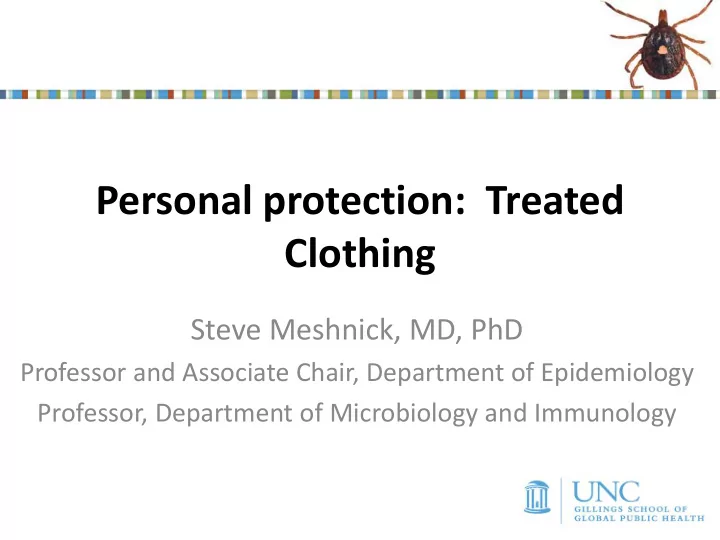

Personal protection: Treated Clothing Steve Meshnick, MD, PhD Professor and Associate Chair, Department of Epidemiology Professor, Department of Microbiology and Immunology
Outline • Clothing and tick bites • Long-lasting permethrin impregnated (LLPI) clothing • Future issues
Prevention of tick bites • Proper attire – long sleeves, tuck long pants into socks • Repellent application onto clothing – DEET – Permethrin • Repellents need to be reapplied frequently
Outdoor workers and tick-borne illnesses Location Seroprevalence against Prevalence Reference New York Borrelia 6.5% (Smith, Benach et al. 1988) UK Borrelia 25% (Guy, Bateman et al. 1989) New Jersey Borrelia 5.7% (Goldstein, Schwartz et al. 1990) Assateague Island, Borrelia 0% (Parrott, Johnson et al. 1993) Maryland New Jersey Borrelia 8.8% (1988) (Schwartz, Goldstein et al. 18.7% (1990) 1993) Italy Borrelia 23.2% (Cinco, Barbone et al. 2004) Poland Borrelia Anaplasma 41% (Cisak, Chmielewska-Badora 17.7% et al. 2005) Turkey Borrelia 10.9% (Kaya, Parlak et al. 2008) Italy Borrelia, TBE Same as controls (Di Renzi, Martini et al. 2010) Italy Rickettsia 3.9% (Cinco, Luzzati et al. 2006)
Long-lasting permethrin-impregnated (LLPI) clothing • Predominantly marked for protection against mosquito-borne diseases – All US Army uniforms are impregnated • Insect Shield treated clothing – Effective for over 70 washes – Safe (EPA approved for all ages) – Invisible, odorless – Commercially available
Pilot Study • Open label study of 16 outdoor workers from NC Division of Water Quality • 9 wore treated clothing • 7 wore untreated clothing • One tick season Vaughn and Meshnick, Vector Borne Zoonotic Dis, 2011.
Tick-borne Illness and Clothing Study
TICS • Double-blinded Randomized Controlled Trial (RCT) • Outdoor workers from the State Divisions of Forestry, Parks and Recreation, Fish and Wildlife
TICS: Data Collection • Annual questionnaires • Weekly tick logs • Tick collection – PCR analyses for pathogens • Annual blood draws – Serologies for tick- borne pathogens
Effectiveness against tick bites N Total tick Tick bites Preventive 95% CI p-value bites/total per person- effective- weeks week ness Year 1 Control 63 493/1413 0.349 0.828 0.677, 0.908 <0.001 Treatment 64 84/1398 0.060 Year 2 Control 48 287/1206 0.238 0.384 -0.514, 0.749 0.291 Treatment 53 181†/1234 0.147 Years 1 & 2 Control 64 780/2619 0.298 0.662 0.341, 0.826 0.004 Treatment 66 265/2632 0.101 >90% of ticks were Lone Star ticks Vaughn et al., Am. J. Prev. Med, 2014
Effectiveness against infection Sero- No Unadjusted RR Adjusted RR conversion infection (95% CI) (95% CI) p-value Control 23 58 Ref Ref Treatment 17 57 0.81 (0.47, 1.39) 0.85 (0.50, 1.44) 0.54 Wallace et al., VBZD, 2016
Summary • LLPI clothing protects against tick bites and mosquito bites for one year • Sample size too small to detect effect on incidence of infection
What about black-legged ticks?
• Evaluate protective effectiveness against black- legged tick in Rhode Island and neighboring states • Measure absorption of permethrin metabolites and potential for toxicity • Measure loss of permethrin and bio-actvity over time under field conditions
Conclusions • Long-lasting permethrin impregnated clothing protects against tick bites for at least 1 year and should be recommended to those at high risk of tick-borne disease • Better insights into factors affect durability of protection are needed. • Need to evaluate alternatives to permethrin
Acknowledgements TICS TICS2 RI Meagan Vaughn Thomas Mathers Sheana Funkhouser Megan Dyer Feng-Cheng Lin John Wallace Jason Fine Sheana Funkhouser Jon Juliano Feng-Cheng Lin Charles Apperson Stephanie Richards Logu Ponnusammy InsectShield William Nicholson CDC/NIOSH InsectShield CDC/NIOSH
Recommend
More recommend